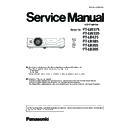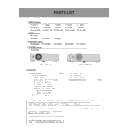Panasonic PT-LW375 / PT-LW335 / PT-LB425 / PT-LB385 / PT-LB355 / PT-LB305 (serv.man3) Service Manual ▷ View online
3
PREFACE
<LW375/LW335/LB425/LB385/LB355/LB305>
Notes on repairing
f
In case of fuse opening inside the projector, Do not turn the projector on just replacing the fuse with new one because there
might be a possibility to have smoking or firing hazard. Turn it on after solving the main cause of fuse opening.
f
After repairing, confirm that the projector operates correctly.
f
Pay attention to handle the projector as customer's personal settings have been remaining inside the projector.
Cautions when transporting
f
When transporting the projector, handle it with care and avoid excessive vibration and impacts. Doing so may damage the
internal parts and result in malfunctions.
f
Do not transport the projector with the adjustable foot extended. Doing so may damage the adjustable foot.
f
(Only for PT-LW375, PT-LW335, PT-LB425, PT-LB385 and PT-LB355)
Do not move or transport the projector with the wireless module (Model No.: ET-WML100) of the optional accessories at-
tached. Doing so may damage the wireless module.
Cautions when installing
r
Do not set up the projector outdoors.
The projector is designed for indoor use only.
r
Do not set up the projector in the following locations.
f
Places where vibration and impacts occur such as in a car or vehicle: Doing so may cause damage to internal components or
malfunction.
f
Locations near the sea or areas affected by corrosive gas: Corrosion may damage internal components or cause the projec-
tor to malfunction.
f
Near the exhaust of an air conditioner: Depending on the conditions of use, the screen may fluctuate in rare cases due to the
heated air from the air exhaust port or the hot or cooled air. Make sure that the exhaust from the projector or other equipment,
or the air from the air conditioner does not blow toward the front of the projector.
f
Places with sharp temperature fluctuations such as near lights (studio lamps): Doing so may shorten the life of the lamp, or
result in deformation of the outer case due to heat, which may cause malfunctions.
Follow the operating environment temperature of the projector.
f
Near high-voltage power lines or near motors: Doing so may interfere with the operation of the projector.
r
Ask a qualified technician or your dealer for the installation work such as installing to a ceiling.
To ensure projector performance and safety, ask a qualified technician or your dealer when installing to a ceiling or in a high
place.
r
Focus adjustment
The projection lens is thermally affected by the light from the light source, making the focus unstable in the period just after
switching on the power. It is recommended that the images be projected continuously for at least 30 minutes before the focus is
adjusted.
r
When using the projector in the elevation of below 700 m (2 297'), make sure [High land] is set to [Off].
Failure to do so may shorten the life of the internal parts and result in malfunctions.
r
When using the projector in the elevation of above 700 m (2 297') and below 1 400 m
(4 593'), make sure [High land] is set to [On 1].
Failure to do so may shorten the life of the internal parts and result in malfunctions.
r
When using the projector in the elevation of above 1 400 m (4 593') and below 2 700 m (8 858'), make
sure [High land] is set to [On 2].
Failure to do so may shorten the life of the internal parts and result in malfunctions.
r
Do not install the projector at elevations of 2 700 m (8 858') or higher above sea level.
Failure to do so may shorten the life of the internal parts and result in malfunctions.
4
PREFACE
<LW375/LW335/LB425/LB385/LB355/LB305>
r
Cautions when setting up the projector
f
Use the adjustable foot only for adjusting the angle. Using them for other purposes may damage the projector.
f
Do not stack the projectors.
f
Do not use the projector supporting it by the top.
f
Do not block the ventilation ports (intake and exhaust) of the projector.
f
Avoid heating and cooling air from the air conditioning system directly blow to the ventilation ports (intake and exhaust) of the
projector.
f
Do not install the projector in a confined space.
When placing the projector in a confined space, a ventilation and/or air conditioning system is required. Exhaust heat may
accumulate when the ventilation is not enough, triggering the protection circuit of the projector.
Within 15°
Within 15°
Within 30°
Within 30°
r
Do not tilt the projector or place it on its side.
Do not tilt the projector body more than approximately ±30 degrees vertically or ±15 degrees horizontally. Over tilting may result
in shortening the life of the components.
For PT-LB305, keystone correction in the horizontal direction is not supported. If the projector is tilted horizontally, horizontal
trapezoidal distortion cannot be corrected.
5
PREFACE
<LW375/LW335/LB425/LB385/LB355/LB305>
For the block diagrams, schematic diagrams and parts list, refer to each separated booklet "Block and Schematic
diagrams" and "Parts List" respectively.
CONTENTS
1. Safety Precautions
2. Specifications
SECTION 1 SERVICE INFORMATION
1. Circuits Protection
2. Maintenance/Replacement
3. Notes on service
4. Troubleshooting
SECTION 2 DISASSEMBLY PROCEDURES
1. Mechanical & Electrical Parts Disassembly
2. Optical Parts Disassembly
SECTION 3 ADJUSTMENTS
1. Adjustments Items and Procedures
2. Optical Adjustment
3. Electrical adjustment
4. Firmware Update Procedure
6
PREFACE
<LW375/LW335/LB425/LB385/LB355/LB305>
1. Safety Precautions
1.1. General Guidelines
- For continued safety, no modification of any circuit must be attempted.
- Unplug the power cord from the power outlet before disassembling this projector.
- Use correctly the supplied power cord and must ground it.
- It is advisable to use an isolation transformer in the AC power line before the service.
- Be careful not to touch the rotation part (cooling fan, etc.) of this projector when you service with the upper case removed
and the power supply turned on.
- Observe the original lead dress during the service. If a short circuit is found, replace all the parts overheated or damaged
by the short circuit.
- After the service, all the protective devices such as insulation barriers, insulation papers, shields, and isolation R-C combi-
nations must be properly installed.
- After the service, check the leakage current to prevent the customer from getting an electric shock.
1.2. Leakage Current Check
1. Prepare the measuring circuit as shown in Fig.1.
Be sure to use a voltmeter having the performance described in Table 1.
2. Assemble the circuit as shown in Fig. 2. Plug the power cord in a power outlet.
3. Connect M1 to T1 according to Fig. 2 and measure the voltage.
4. Change the connection of M1 from T1 to T2 and measure the voltage again.
5. The voltmeter must read 0.375 V or lower in both of steps 3 and 4. This means that the current must be 0.75mA or less.
6. If the reading is out of the above standard, the projector must be repaired and rechecked before returning to the customer
because of a possibility of an electric shock.
M1
M2
Rs
Cs
Rb
10KΩ ±0.1%
0.022µF
±1.0%
Vb
(V) V
Rs: 1500 Ω±0.1%
Cs: 0.22 µF±1.0%
Rb: 500 Ω±0.1%
to T1
or T2
in FIg.2
Weighted leakage current=Vb / 500 (A)
Fig. 1
Isolation transformer
T1
T2
connection
to power outlet
M1
M2
Fig.2
Projector
Measuring
Circuit (Fig.1)
Performance
Voltmeter
(rms reading)
Accurancy:
≤ 2%
Input resistance:
≥ 1 MΩ
Input capacitance: ≤ 200 pF
Frequency range: 15 Hz to 1 MHz
Table 1
1.3. UV Precaution and UHM Lamp Precautions
- Be sure to unplug the power cord from the power outlet when replacing the lamp.
- Because the lamp reaches a very high temperature during its operation, wait until it cools completely when replacing the
Lamp Unit.
- The lamp emits small amounts of UV-radiation, avoid direct-eye contact with the light.
- The lamp unit has high internal pressure. If improperly handled, explosion might result.
- Because the high pressure lamp involves a risk of failure, never touch the lamp wire lead during the service.



